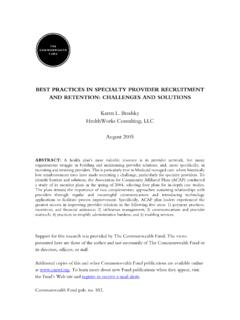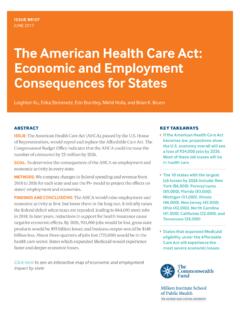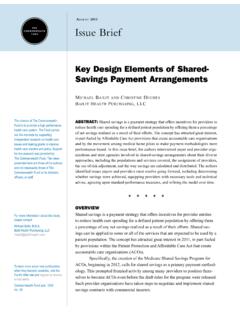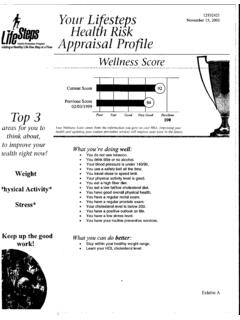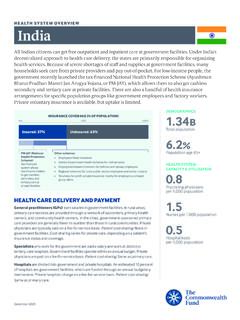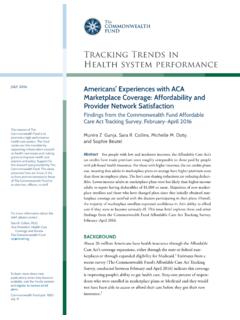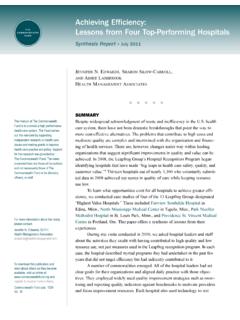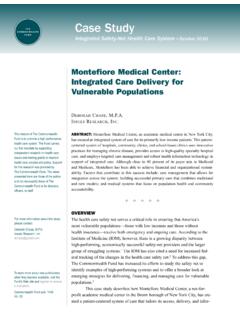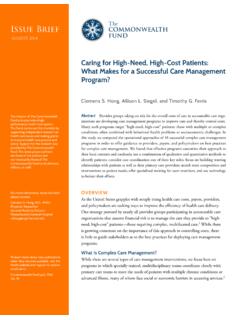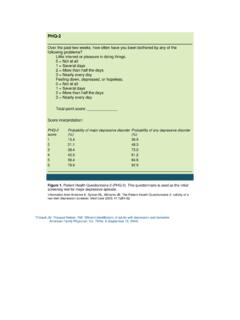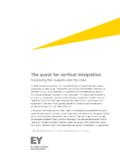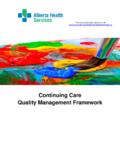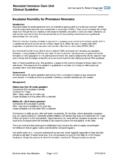Transcription of Developing a Framework for Evaluating the Patient ...
1 Issue BriefTheCOMMONWEALTH FUNDI ssue BriefFERBUARY 2016 Developing a Framework for Evaluating the Patient Engagement, Quality, and Safety of Mobile health ApplicationsKarandeep Singh, Kaitlin Drouin, Lisa P. Newmark, Ronen Rozenblum, Jaeho Lee, Adam Landman, Erika Pabo, Elissa V. Klinger, and David W. BatesAbstract Rising ownership of smartphones and tablets across social and demographic groups has made mobile applications, or apps, a potentially promising tool for engaging patients in their health care, particularly those with high health care needs. Through a systematic search of iOS (Apple) and Android app stores and an analysis of apps targeting individuals with chronic illnesses, we assessed the degree to which apps are likely to be useful in Patient engagement efforts.
2 Usefulness was determined based on the following criteria: description of engagement, relevance to the targeted Patient population, consumer ratings and reviews, and most recent app update. Among the 1,046 health care related, Patient -facing applications identified by our search, 43 percent of iOS apps and 27 percent of Android apps appeared likely to be useful. We also developed criteria for Evaluating the Patient engagement, quality, and safety of mobile evidence suggests that health care is more efficient and effective when patients are actively engaged in their Engaged, or activated, patients col-laborate with their providers, are treated with respect and dignity, receive information related to their care, and are involved in Two separate reviews com-missioned by the Institute of Medicine and Robert Wood Johnson Foundation found that chronic disease self-management and promotion of Patient engagement are essen-tial to successful care management programs targeting patients with high needs and high costs and are associated with improved quality of life, functional autonomy.
3 And decreased hospital health applications, or apps, designed for smartphones can help empower high-need, high-cost patients to self-manage their health . Nearly two-thirds of Americans now own smartphones, and ownership is rising among older adults (27%) and those with low household incomes (50%).4 Moreover, community health centers and clinics perceive mobile health technologies as an ideal tool to engage their Patient populations in chronic disease this issue brief, we describe criteria for Evaluating mobile apps for high-need, high-cost populations based on their potential to improve Patient engagement and on their quality and safety. We then discuss results of our efforts to test and refine those criteria using a sample of apps available through the Apple iOS and Android app learn more about new publications when they become available, visit the Fund s website and register to receive email Fund pub.
4 1863 Vol. 5 The mission of The Commonwealth Fund is to promote a high performance health care system. The Fund carries out this mandate by supporting independent research on health care issues and making grants to improve health care practice and policy. Support for this research was provided by The Commonwealth Fund. The views presented here are those of the authors and not necessarily those of The Commonwealth Fund or its directors, officers, or more information about this brief, please contact:Karandeep Singh, , ProfessorDepartment of Learning health SciencesUniversity of Michigan Medical The Commonwealth FundHOW WE CONDUCTED THE STUDYWe identified mobile applications targeting high-need, high-cost patients through a systematic search of the Apple iOS iTunes and Android Google Play app stores.
5 Our focus was on Patient -facing apps those targeted for use by individuals with chronic illnesses. We evaluated the app store descrip-tions to identify and characterize the different components that may influence level of Patient engage-ment, quality, and Potentially Useful, health -Related, Patient -Facing ApplicationsWe searched for apps using the following terms: alcohol, arthritis, asthma, bipolar, cancer, cirrho-sis, cognitive impairment, chronic obstructive pulmonary disease, COPD, coronary artery disease, dementia, depression, diabetes, drug abuse, elderly, heart disease, heart failure, high blood pressure, hypertension, kidney disease, liver disease, lung disease, obesity, pain, smoking, and stroke. We selected the first 50 listings for each of the 26 search removing those that were non- health -related, non- Patient -facing, non-English, and highly similar ( , lite or pro versions), we evaluated the apps potential usefulness based on description, total number of ratings, mean cumulative ratings, consumer reviews, screenshots, and date of most recent update.
6 Apps were considered unlikely to be useful if they had minimal function-ality beyond traditional media such as books and videos, were not relevant to the searched illness, were poorly rated or reviewed by consumers, or were not intended for broad use ( , inaccessible without specific login credentials). Developing a Framework for Evaluating Mobile health AppsFor apps that appeared potentially useful, we developed an initial set of general criteria to evaluate them on the basis of Patient engagement, quality, and safety. The criteria were informed by existing app evaluations and frameworks, as well as our review of app store We also solicited open-ended responses from reviewers to each of these domains to determine if criteria needed to be removed, refined, or added.
7 The evaluation Framework was piloted by eight reviewers on two to three apps each and adjusted based on the reviewers conceptualized Patient engagement as the ability for apps to enable collaboration, acti-vation and participation, information-sharing, and decision-making in one s own health . Patients may differ to the extent to which they participate in their health care, and we wanted to evaluate the degree to which apps may enable patients to increase their engagement. We constructed and used an engagement pyramid (Exhibit 1) to determine how apps are meeting the needs of patients with differ-ing levels of health care engagement. Patients who are least activated in their own care may face health literacy or social barriers to care, which can be addressed through health education, reminders, and recording of health information.
8 These functions do not require smartphone apps, though apps pro-vide a new platform through which to store and deliver information. Moderately activated patients who are informed and able to keep track of their health may benefit from being able to visualize and summarize their health information, receive guidance on next steps, and communicate with family members and health care providers. Finally, the most engaged patients may benefit from peer sup-port delivered through social media or ongoing motivational challenges that can be delivered through gamification that is, using elements of game design, like competition or point scoring, to make an activity more a Framework for Evaluating Mobile health Applications 3We considered quality in terms of reliability of information for the targeted population, rec-ommendability, and usability.
9 Two aspects of safety were considered: the ability for an app to handle dangerous information entered by a Patient ( , low blood sugar or suicidal thoughts) and the commitment of the app developer to respect Patient information privacy and FINDINGSM inority of Apps Appear Likely to Be Useful in Engaging PatientsA systematic search of the iOS and Android app stores for a broad set of medical conditions revealed 946 iOS apps and 1,173 Android apps. After removing non- health -care, non- Patient -facing, non-English, and highly similar apps, 376 iOS apps and 569 Android apps remained (Exhibit 2).Of the 376 iOS apps: 24 (6%) appeared to have limited engagement beyond traditional media 66 (18%) were not relevant to the search condition 33 (9%) had poor ratings or reviews, 63 (17%) were last updated prior to 2014 29 (8%) were otherwise not assessed to be 1.
10 Strategies to Ac vate Pa ents Using Mobile Applica ons Based on Level of Engagement with health CareProviding educa onal informa onReminding or aler ng usersRecording and tracking health informa onDisplaying and summarizing health informa onProviding guidance based oninforma on entered by the userEnabling communica onwith clinicians, familymembers, and caregiversProvidingsupport throughsocial networksSuppor ng behavior change through rewardsLevels of engagement4 The Commonwealth FundOf the 569 Android apps: 89 (16%) had limited engagement 56 (10%) were not relevant to the search condition 8 (1%) had poor ratings or reviews, 200 (35%) were last updated prior to 2014 64 (11%) were otherwise not assessed to be all, 161 (43%) iOS apps and 152 (27%) Android apps were assessed as possibly useful, of which 126 apps existed on both 2.
